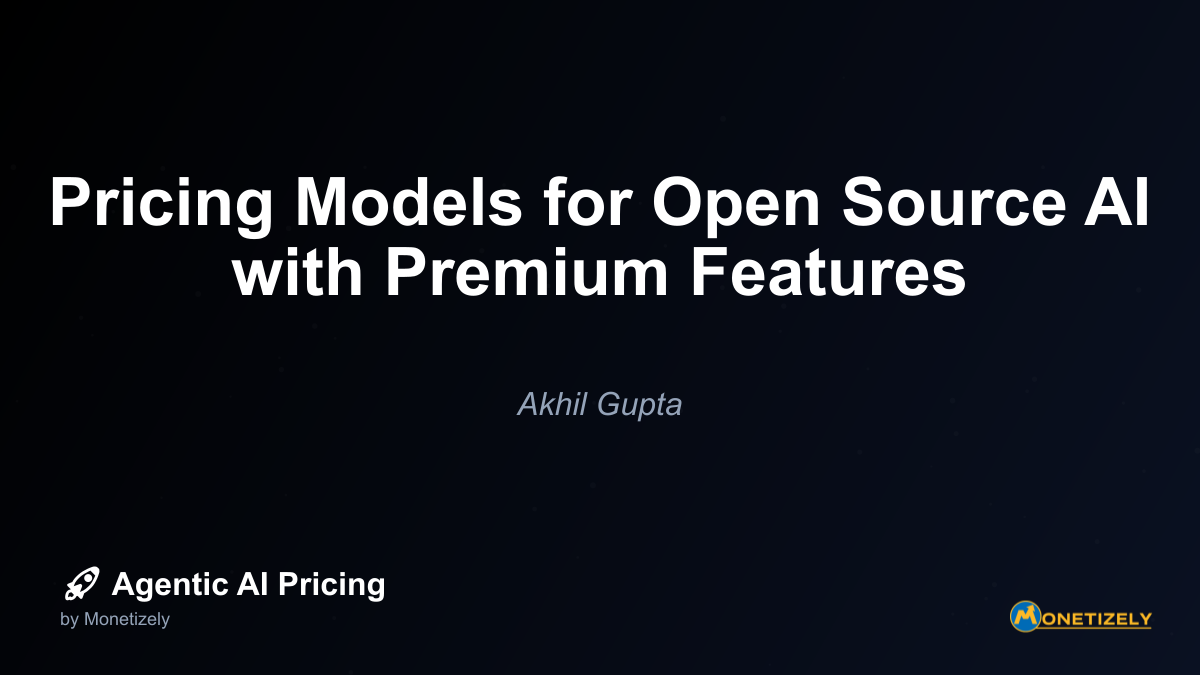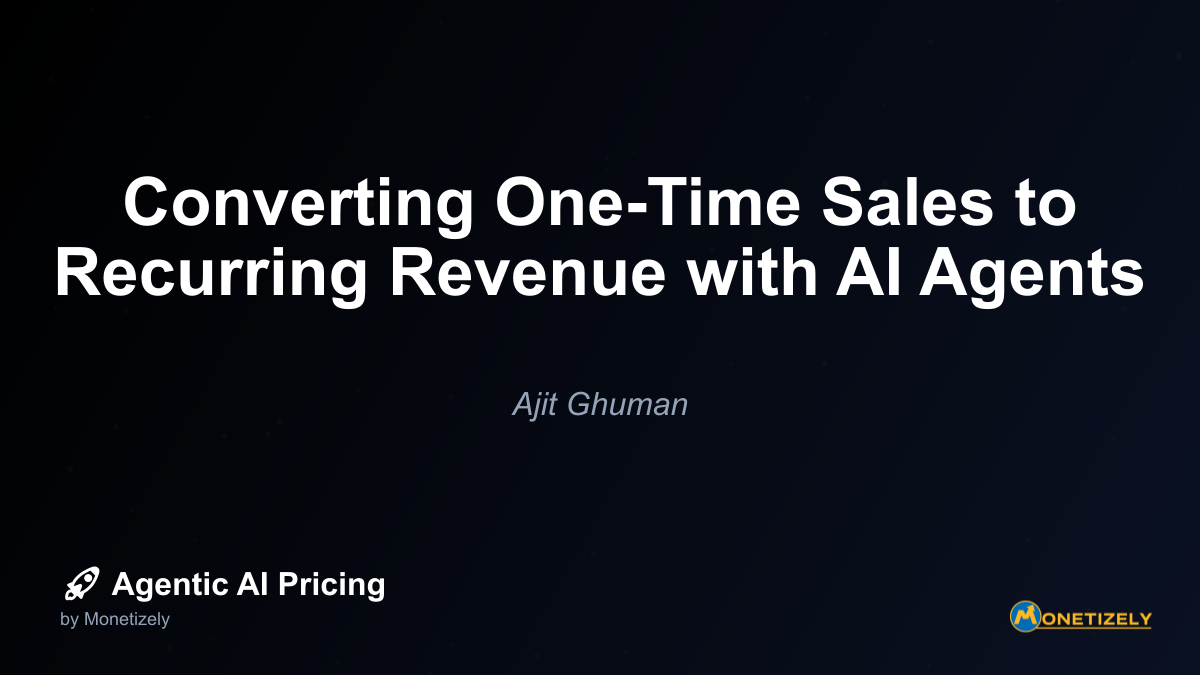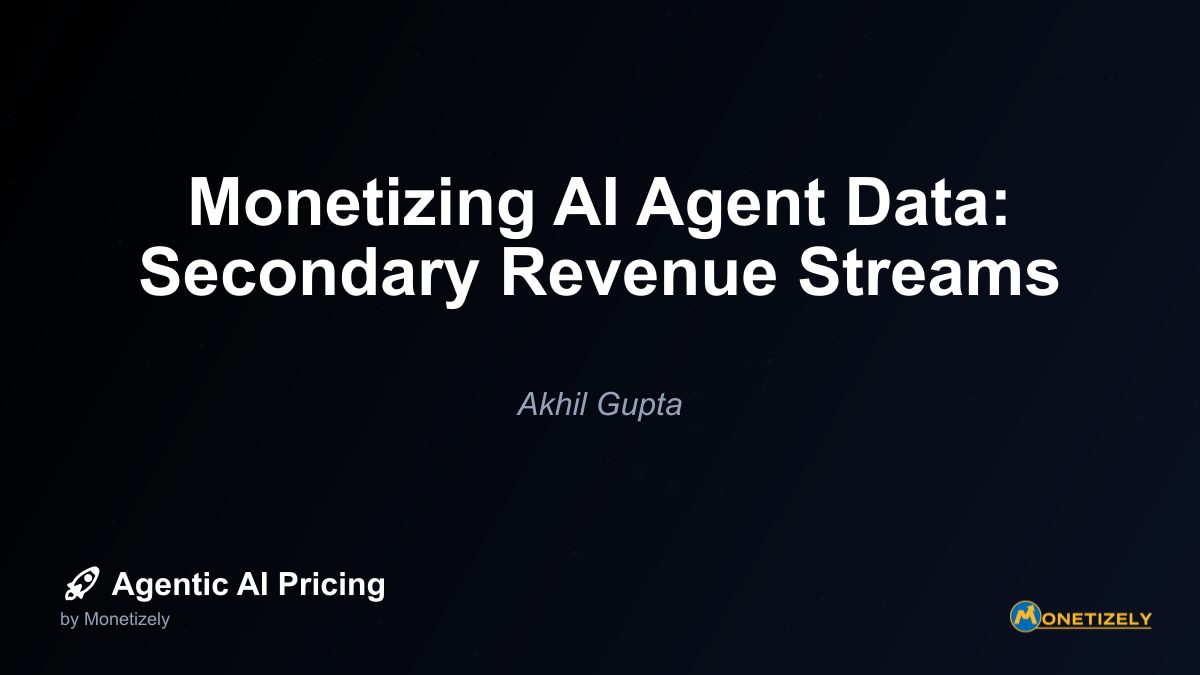· Akhil Gupta · Business Models · 12 min read
Pricing Models for Open Source AI with Premium Features
AI and SaaS Pricing Masterclass
Learn the art of strategic pricing directly from industry experts. Our comprehensive course provides frameworks and methodologies for optimizing your pricing strategy in the evolving AI landscape. Earn a professional certification that can be imported directly to your LinkedIn profile.

In the rapidly evolving world of artificial intelligence, open source models have become foundational to innovation and accessibility. However, companies face the challenge of balancing open collaboration with sustainable business models. This deep dive explores how organizations can effectively monetize open source AI through premium feature offerings—creating value for both community users and paying customers.
The Open Source AI Landscape in 2025
The AI market has matured significantly in recent years, with open source models playing an increasingly central role in the ecosystem. Companies have recognized that open source AI offers unique advantages for building community, accelerating adoption, and fostering innovation while still providing opportunities for monetization.
Open source AI projects with premium features typically follow several dominant pricing models:
Core Pricing Models for Open Source AI
Freemium and Community Editions: Many companies offer free community editions to build user bases and foster innovation. Monetization comes through premium features, support, or integrations in commercial editions. Open source frameworks remain free to use, while hosted versions or advanced capabilities carry fees.
Usage-Based (Consumption) Pricing: This model charges per API call, per token processed, or per task outcome, aligning costs with the user’s actual consumption of resources. OpenAI charges per 1,000 tokens, with Microsoft and others adopting similar models to help manage the high compute costs of AI.
Tiered Pricing and Subscriptions: SaaS providers price AI features in tiers, scaling features and usage limits with price. Higher tiers unlock more advanced or business-critical AI capabilities, nudging users to upgrade. Jasper’s tiered plans and Zapier’s task-based tiers exemplify this approach.
Outcome-Based Pricing: Increasingly, vendors tie charges to measurable business outcomes produced by AI (e.g., sales meetings booked, support tickets resolved). This aligns pricing with customer ROI but is complex to implement. Zendesk and Salesforce experiment with such models, reporting improved adoption and customer satisfaction.
Commercial Licenses: Some open source AI vendors offer licenses for enterprise usage, including SLA-backed commercial support and integration services. This hybrid model helps monetize while maintaining a free core product for community users.
Market Trends (2023-2025)
Recent market trends in open source AI monetization show several important developments:
AI pricing is trending toward experimenting with hybrid and blended models combining fixed fees and metered usage to balance revenue stability with flexibility.
There is increased emphasis on cost containment and predictable pricing, demonstrated by new rate limits in subscriptions like Anthropic’s Claude Pro to control usage spikes and improve margin health.
Providers are focusing on high-value professional and enterprise plans priced at $20 to $250+ monthly to serve business customers with guaranteed performance and expanded features.
The rise of agentic AI products (autonomous AI agents) introduces new pricing units like “agentic seats” that charge based on licensed autonomous task performers rather than mere users.
Case Studies: Leading Open Source AI Companies
Hugging Face
Business Model & Offering:
Hugging Face is a leading open source AI platform hosting 200+ models and datasets, including the famous Transformers library. The core platform and models are free to use, encouraging community contributions and collaborations. Revenue is largely generated via premium subscriptions, compute usage fees, and enterprise features.
Pricing Tiers:
| Tier | Price | Free vs. Paid Features |
|---|---|---|
| Free | $0/month | Basic model access, limited inference credits ($0.10/month), community features |
| Pro | $9/month | 20× more inference credits, 10× private storage capacity, prioritized compute queue, private dataset viewer, publishing blogs, early access to features, ZeroGPU hosting tiers |
| Team | Starts at $20/user/month (approx.) | SSO & SAML, audit logs, granular access control, centralized billing, organization-wide premium perks |
| Enterprise | Custom pricing, enterprise onboarding | All Team features plus legal/compliance support, personalized onboarding, managed billing, premium support |
Feature Split:
- Free: Access to hosted open source models, community datasets, and spaces (interactive model demos).
- Paid: Advanced compute, priority queue, private storage for datasets and models, team/enterprise collaboration and security features.
Billing Options:
Flexible pay-as-you-go billing either through Hugging Face’s routed provider mechanism (credits apply), or direct with cloud/inference providers.
Community and Commercial Balance:
Hugging Face maintains a strong open source ethos by making the core models and datasets free and encouraging community contributions. Premium features target power users and enterprises needing scale, governance, or advanced capabilities. They also allow monetization of “Spaces” (model demos/web apps hosted on their platform) through gated access or pay-per-use approaches, balancing openness with recouping costs for inferencing/external APIs.
Stability AI
Business Model & Offering:
Stability AI pioneered openly releasing large generative models (e.g., Stable Diffusion). Their models are open source, but the company monetizes by offering cloud-based API access, enhanced tooling, and enterprise services.
Pricing Overview:
- Free usage tier for community and experimental use.
- Paid tiers providing higher quotas, faster performance, and commercial licenses.
- Enterprise contracts including dedicated SLAs, custom support, and deployment options for production AI services.
Feature Split:
- Free: Access to stable diffusion models and weights.
- Paid: Hosted API access with guaranteed uptime, priority usage, custom integrations.
Community vs Commercial:
Stability AI openly releases core models but retains commercial licensing for production usage, cloud APIs, and enterprise deployments, enabling community innovation while funding continued development.
Meta’s LLaMA (LLaMA 2)
Model Release:
Meta released LLaMA and LLaMA 2 models as open source under specific research licenses, promoting wide community use.
Monetization:
Meta does not directly charge for the models but may integrate these models into proprietary Meta products or cloud services, balancing broad access with commercial interests internally.
MongoDB (Illustrative Example)
While not an AI company specifically, MongoDB’s approach to open source monetization offers valuable lessons for AI companies:
MongoDB’s core database is open source under Server Side Public License, while they monetize through MongoDB Atlas, a fully managed cloud database service with advanced security, automation, and scalability features.
- Model: Managed service subscription with premium capabilities beyond open source community edition.
- Revenue: $700M+ annual revenue, showing effective monetization of open source base.
- Strategy: Enterprise-friendly SLAs, additional tools for monitoring, backup, and compliance.
- Lesson: Managed offerings reduce friction for enterprise adoption and generate recurring revenue.
Successful Monetization Strategies
Several key strategies have proven successful for companies monetizing open source AI:
Open Core Model: Keep base AI models or tools fully open source but lock enterprise-grade features under a subscription.
Managed Services: Offer fully managed, hosted versions of the open source models with premium SLAs and operational support.
Enterprise Features: Focus on security, compliance, governance, and integration capabilities that enterprise customers demand.
Community Engagement: Maintain active community involvement to ensure continued innovation and adoption.
Transparent Value Communication: Clearly articulate the value of premium features to justify the price.
Lessons Learned from Successes and Failures
From analyzing successful and less successful open source AI monetization efforts, several key lessons emerge:
Success Factors:
- Having a compelling free core is key, but premium features must solve enterprise pain points (security, compliance, scalability).
- Providing managed cloud services helps convert developers into paying business customers by removing operational overhead.
- Community engagement and trust build a large user base that can convert later to paid plans.
- Transparent licensing and governance avoid community backlash.
Common Failures:
- Some projects attempting to monetize open source AI failed by restricting access too early or too aggressively, alienating community users and eroding trust.
- Overly complex or expensive premium tiers without clear incremental value have limited uptake.
- Failure to clearly differentiate between open source and premium offerings results in poor conversion rates.
- Lack of enterprise readiness or poor customer support undermines willingness to pay.
Legal and Licensing Considerations
The choice of open source license significantly impacts monetization strategies for AI companies. Understanding these implications is crucial for building a sustainable business model.
Open Source Licenses and Their Impact on Monetization
Open source licenses broadly fall into permissive and copyleft categories; each affects monetization strategies differently.
| License | Type | Key Characteristics | Impact on Monetization |
|---|---|---|---|
| MIT License | Permissive | Very short, allows almost unrestricted use, modification, and redistribution as long as copyright and license notice remain. | Allows commercial use, including integrating into proprietary/premium features without requiring open sourcing derivatives. |
| Apache License 2.0 | Permissive | Requires inclusion of copyright, license notices, and marking changes; includes an explicit patent grant protecting users. | Encourages commercial use by providing patent protection; permits proprietary extensions and premium add-ons. |
| BSD License | Permissive | Similar to MIT; multiple versions with slightly different stipulations on notices and usage. | Permissive for commercial monetization; derivative works can have different licenses. |
| GPL (v2 and v3) | Copyleft | Strong copyleft requiring derivatives and larger works to be licensed under GPL, ensuring code remains open source. | Limits monetization by requiring any derivative or distributed software to be open source under GPL; difficult to create proprietary premium features without releasing source. |
| AGPL 3.0 | Strong copyleft | Like GPL but closes the SaaS “loophole” by requiring remote users to get source code of modified server-side software. | Restricts monetization on hosted services unless source is shared; premium cloud features must comply by sharing code. |
| LGPL | Weak copyleft | Mainly for libraries; allows linking from proprietary software without applying LGPL to entire project, only modified library. | More business friendly than GPL—allows proprietary premium products using LGPL libraries without open sourcing whole product. |
Licenses like MIT, Apache, and BSD facilitate monetization through:
- Offering premium closed-source features or enterprise add-ons built atop the open source core.
- Selling support, consulting, SaaS hosting, or custom integrations without open source release on proprietary parts.
- Leveraging patent grants (Apache) to minimize IP risks.
In contrast, GPL and AGPL licenses enforce open sourcing of derivative works or SaaS modifications, making direct commercialization of proprietary extensions challenging unless dual licensing or exceptions are used.
Intellectual Property Rights, Patents, and Trademarks
Companies monetizing open source AI often manage IP by:
Patents: Some permissive licenses like Apache 2.0 include explicit patent grants to licensees, reducing patent litigation risks when contributing/using open source AI. Companies holding patents on AI innovations may contribute code under permissive licenses to encourage adoption while protecting patented methods.
Copyright: All open source licenses require that copyright notices remain intact. Companies emphasize including copyright and license headers in each source file to maintain legal attribution and license enforceability.
Trademarks: While code may be open source, trademarks (product names, logos) are usually protected separately by companies to control brand use and avoid confusion in the market, enabling monetization through brand recognition and premium offerings.
Dual Licensing: Some companies use dual licensing (open source under GPL or other licenses for community use and separate commercial licenses for proprietary use) to monetize while ensuring community engagement.
Regulatory Considerations and Compliance
Pricing and monetization of open source AI also intersect with regulatory and compliance issues, including:
Export Controls and Data Privacy: AI software that uses or processes personal data must comply with regulations such as GDPR, CCPA, or AI-specific emerging laws, influencing how companies price premium services that include data handling or cloud-based AI capabilities.
Open Source Compliance: Companies must comply with open source license obligations (e.g., disclosure, attribution) which can affect the structuring of paid offerings to clearly separate open source components from proprietary premium features.
Competition and Antitrust: In some jurisdictions, monetization models must consider antitrust regulations. Offering open source AI with premium tiers must avoid anti-competitive practices.
Transparency and Explainability: Emerging AI regulations may require transparency in AI operations; companies might price premium features that provide explainability, audit logs, or compliance certifications.
SaaS Licensing Models: Licenses like AGPL require source disclosure for server-side code, which influences pricing models for cloud-hosted AI. Companies often build proprietary layers on top of open source to justify subscription fees while complying with license terms.
Strategic Pricing Framework for Open Source AI
A well-designed pricing strategy for open source AI with premium features involves balancing free access to core capabilities while monetizing advanced functionalities.
Frameworks for Determining Free vs. Premium Features
Core Free Features: Provide essential, broadly useful AI capabilities to build a large user base and community engagement. Free tiers often include limited usage quotas, access to base models, and community support. This approach lowers barrier to adoption and spawns potential paying customers.
Premium Features: Offer enhanced model quality (e.g., advanced language models), faster response times, priority access, dedicated capacity, enterprise-grade security, and specialized functionalities like AI agents for complex automation. These justify premium pricing for professional or high-volume users.
Segmentation of Features by Value and Usage:
- Entry-level users: Access to standard AI models, moderate usage limits, basic features.
- Power users: Faster speeds, higher usage caps, access to improved models/features.
- Enterprise users: Dedicated resources, service-level agreements, customization, compliance support.
Implementation Guidance: Adopt a tiered freemium model or blended pricing combining fixed fees with usage-based charges. Use usage caps and fair use policies to manage cost predictability and prevent abuse.
Pricing Psychology
- Pricing often reflects perceived value rather than strict cost basis, especially in AI where development and operational costs can be opaque or extremely high.
- Premium tiers are often set significantly higher than entry tiers to create aspirational status and distinguish offerings (e.g., $20/month base vs. $200/month premium).
- Anchoring higher price points on enterprise-specialized capabilities supports justification of premium rates.
- Follow-the-leader pricing effectively sets market expectations in emerging AI segments, with pricing clustering around established benchmarks (e.g., $200 for advanced AI subscriptions).
Customer Segmentation & Value-Based Pricing
- Segmentation should be based on:
- Usage volume/frequency
- Need for features like SLA, integration, domain expertise
- Willingness and ability to pay (startups, SMBs, enterprises)
- Value-Based Pricing: Set price proportional to the business outcomes or productivity gains AI features provide. For example, autonomous AI agents commanding $2,000–$20,000/month reflect the value to enterprises automating complex labor.
- Use customer feedback, purchase behavior, and competitive benchmarking to refine value estimates and price tiers.
Tactical Implementation Guidance
- Start with a freemium tier that is compelling enough to attract developers and small teams but enforces meaningful limits.
- Introduce tiered subscriptions blending flat monthly fees with usage caps and overage charges to cater to diverse users and maximize revenue.
- Offer enterprise plans with volume discounts, dedicated throughput, enhanced support, and negotiated pricing to lock in high-value customers.
- Communicate clearly the benefits of premium features to reduce friction when upselling (e.g., speed, reliability, priority access).
- Develop usage analytics and dashboards so customers understand consumption and value, aiding willingness to pay.
Measuring Success & Key Metrics
- Adoption metrics: Number of active users at free and paid tiers, conversion rates from free to premium.
- Revenue metrics: MRR (Monthly Recurring Revenue), ARPU (Average Revenue per User), churn rate.
- Engagement metrics: Usage frequency, feature adoption rates, session length.
- Cost metrics: Compute costs per user/premium features to monitor profitability.
- Customer satisfaction: NPS (Net Promoter Score), support tickets, feedback on premium value.
Evolving Pricing Over Time
- As open source alternatives mature and market competition intensifies, reassess the distinctiveness and value of premium features.
- Consider introducing new premium capabilities or bundling (e.g., domain-specific AI, integrations) to sustain price premiums.
- Adjust pricing tiers based on customer feedback, competitive moves, and cost shifts (e.g., cheaper compute).
- Experiment with innovative pricing models like outcome-based or agent-seat licensing for advanced autonomous AI applications.
- Maintain flexibility to respond quickly to market signals and user willingness to pay while protecting revenue streams.
Community Building and Engagement Strategies
Building and maintaining a
Co-Founder & COO
Akhil is an Engineering leader with over 16+ years of experience in building, managing and scaling web-scale, high throughput enterprise applications and teams. He has worked with and led technology teams at FabAlley, BuildSupply and Healthians. He is a graduate from Delhi College of Engineering and UC Berkeley certified CTO.
Pricing Strategy Audit
Let our experts analyze your current pricing strategy and identify opportunities for improvement. Our data-driven assessment will help you unlock untapped revenue potential and optimize your AI pricing approach.




